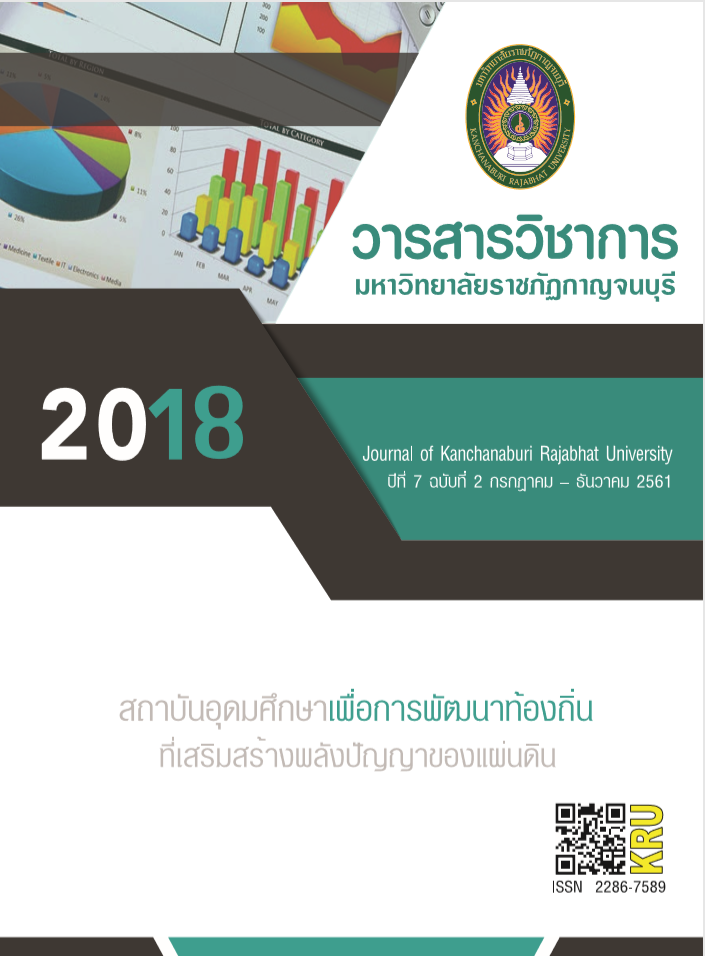Factors influencing the user behavior of Faculty of Management Science Bansomdejchaopraya Rajabhat University's website
Main Article Content
Abstract
ABSTRACT
The purposes of this research are to study the 1) demographic characteristics of internet users including gender, age and level of education (including current students), location of use and experience of using internet; 2) behaviors of internet users toward the official website of the Faculty of Management Science, Bansomdejchaopraya Rajabhat University including the frequency of use, duration of use at a time and period of use; 3) the 5 aspects of internet users’ attitudes toward the official website of the Faculty of Management Science, Bansomdejchaopraya Rajabhat University including content, design, links, interaction and time; and 4) relationship between internet users’ attitudes and users’ behaviors toward the official website of the Faculty of Management Science. The research samples were composed of 384 users. The data collection was conducted using the online questionnaire embedded on the official website of the Faculty of Management Science, Bansomdejchaopraya Rajabhat University (ms.bsru.ac.th), where the internet users could directly respond to questions. The Statistical Package for the Social Science (SPSS) was used to analyze the gathered data. The statistic methods used to analyze the data were percentage, mean and standard deviation. The statistics used for hypothesis testing were t-test, one-way ANOVA, Scheffe’s test, multiple regression analysis and Pearson product moment correlation coefficient.
The results were as follows:
1) The majority of respondents were female, aged 15-24 years holding bachelor degree, access to the internet from office/educational institution and experienced in using internet for 1-3 years.
2) The internet users’ behaviors toward the official website of the Faculty of Management Science, Bansomdejchaopraya Rajabhat University, in terms of the frequency of using the website was at 3-4 times per week. The duration of using the website at a time was 31 minutes to 1 hour. The period when the respondents accessed the most was 12:01-17:00 (afternoon).
3) The attitudes toward the content, design and links of official website of the Faculty of Management Science, Bansomdejchaopraya Rajabhat University were at very good level and attitudes toward interaction and time were at good level.
4) The results of the relationship between internet users’ attitudes and users’ behaviors toward the official website of the Faculty of Management Science were divided according to the 5 aspects of attitudes. First, the content was reliable. Second, the interaction in terms of controlling the animation of the news on the first page of the website was easy. Third, the fast time used for downloading had quite low relationship with users’ behaviors toward the official website of the Faculty of Management Science, in terms of average of time using the website at a time; the time and users’ behaviors also had opposite relationship. In other words, if the reliability of content had improved, the time used for downloading would have been faster; but the average of time using the website had remained constant. This showed that users’ needed only their desired information. Finally, there was no relationship found among the design, link and the users’ behaviors toward the official website of the Faculty of Management Science.
Article Details

This work is licensed under a Creative Commons Attribution-NonCommercial-NoDerivatives 4.0 International License.
References
เอกสารอ้างอิง
กรรณิการ์ ง่วนชู. (2554). ปัจจัยที่มีผลต่อพฤติกรรมการซื้อสินค้าทางอินเทอร์เน็ต กรณีศึกษาเว็บไซต์สนุก ดอทคอม. วิทยานิพนธ์ปริญญา
บริหารธุรกิจมหาบัณฑิต สาขาวิชาการตลาด มหาวิทยาลัยรามคำแหง.
กัลยา วานิชย์บัญชา. (2555). สถิติสำหรับงานวิจัย (พิมพ์ครั้งที่ 6). กรุงเทพฯ : จุฬาลงกรณ์มหาวิทยาลัย.
กัลยานี เลื่องสุนทร. (2553). ปัจจัยที่มีผลกับพฤติกรรมการเยี่ยมชมเว็บไซต์การศึกษา กรณีศึกษา: เว็บไซต์ วิชาการ ดอทคอม
(www.vchakarn.com). การค้นคว้าอิสระวิทยาศาสตรมหาบัณฑิต สาขาวิชาการบริหารเทคโนโลยี วิทยาลัยนวัตกรรม มหาวิทยาลัยธรรมศาสตร์. จุฑามณี คายะนันทน์. (2554). พฤติกรรมและผลกระทบจากการใช้เครือข่ายสังคมออนไลน์เฟซบุ๊คดอทคอม
(www.facebook.com). โครงการเฉพาะบุคคลวารสารศาสตรมหาบัณฑิต สาขาวิชาการบริหารสื่อสาร มวลชน
คณะวารสารศาสตร์และสื่อสารมวลชน มหาวิทยาลัยธรรมศาสตร์.
ฉัตยาพร เสมอใจ. (2550). พฤติกรรมผู้บริโภค. กรุงเทพฯ : ซีเอ็ดยูเคชั่น.
ชฏาภา อนันต์กิตติกุล. (2554). ความสัมพันธ์ระหว่างพฤติกรรมการใช้เว็บไซต์เครือข่ายสังคมออนไลน์กับความ ผูกพันทุ่มเทของลูกค้า.
วิทยานิพนธ์ปริญญาการจัดการมหาบัณฑิต สาขาวิชาเทคโนโลยีการจัดการ มหาวิทยาลัยเทคโนโลยีสุรนารี.
ชูศรี วงศ์รัตนะ. (2553). เทคนิคการใช้สถิติเพื่อการวิจัย (พิมพ์ครั้งที่ 12). กรุงเทพฯ: ไทเนรมิตกิจ อินเตอร์ โปรเกรสซิฟ.
เชาว์ โรจนแสง. (2553). การวิเคราะห์พฤติกรรมผู้บริโภค. กรุงเทพฯ : มหาวิทยาลัยสุโขทัยธรรมาธิราช.
ธนิต ศิริมงคล. (2556). พฤติกรรมการใช้เว็บไซต์ Facebook ของประชาชนในกรุงเทพมหานคร. วิทยานิพนธ์ ปริญญา ศิลปศาสตรมหาบัณฑิต สาขาเทคโนโลยีสื่อสารมวลชน มหาวิทยาลัยรามคำแหง.
ธานินทร์ ศิลป์จารุ. (2552). การวิเคราะห์และวิจัยข้อมูลทางสถิติด้วย SPSS (พิมพ์ครั้งที่ 10). กรุงเทพฯ : บิซิเนสอาร์ แอนด์ดี.
ผ่องพรรณ ตรัยมงคลกูล และสุภาพ ฉัตราภรณ์. (2555). การออกแบบการวิจัย (พิมพ์ครั้งที่ 7). กรุงเทพฯ : มหาวิทยาลัยเกษตรศาสตร์.
ฝ่ายพัฒนามาตรฐานระบบรัฐบาลอิเล็กทรอนิกส์ สำนักสถาปัตยกรรมรัฐบาลอิเล็กทรอนิกส์ สำนักงานรัฐบาล อิเล็กทรอนิกส์ (องค์การมหาชน). (2560). มาตรฐานเว็บไซต์ภาครัฐ 2.0 (Government Website Standard Version 2.0). กรุงเทพฯ : สำนักงานรัฐบาลอิเล็กทรอนิกส์ (องค์การมหาชน) สังกัดกระทรวงเทคโนโลยีสารสนเทศและการสื่อสาร. มุทิตา เตชะศิวนาถ. (2554). ทัศนคติและพฤติกรรม
ของผู้ใช้บริการ เว็บบอร์ด พันทิปคาเฟ่. สารนิพนธ์ปริญญา บริหารธุรกิจมหาบัณฑิต สาขาวิชาการจัดการ
มหาวิทยาลัยศรีนครินทรวิโรฒ.
ยุทธ ไกยวรรณ์. (2553). หลักสถิติวิจัยและการใช้โปรแกรม SPSS. กรุงเทพฯ: จุฬาลงกรณ์มหาวิทยาลัย.
ยุทธนา ธรรมเจริญ. (2550). พฤติกรรมผู้บริโภค. กรุงเทพฯ : จุฬาลงกรณ์มหาวิทยาลัย.
วรัญญา ภัทรสุข. (2557). ระเบียบวิธีวิจัยทางสังคมศาสตร์. กรุงเทพฯ : จุฬาลงกรณ์มหาวิทยาลัย.
สำนักงานสถิติแห่งชาติ กระทรวงเทคโนโลยีสารสนเทศและการสื่อสาร. (2558). สำรวจการมีการใช้เทคโนโลยี สารสนเทศและการสื่อสาร
ในครัวเรือน พ.ศ. 2558. กรุงเทพฯ : สำนักสถิติพยากรณ์.

